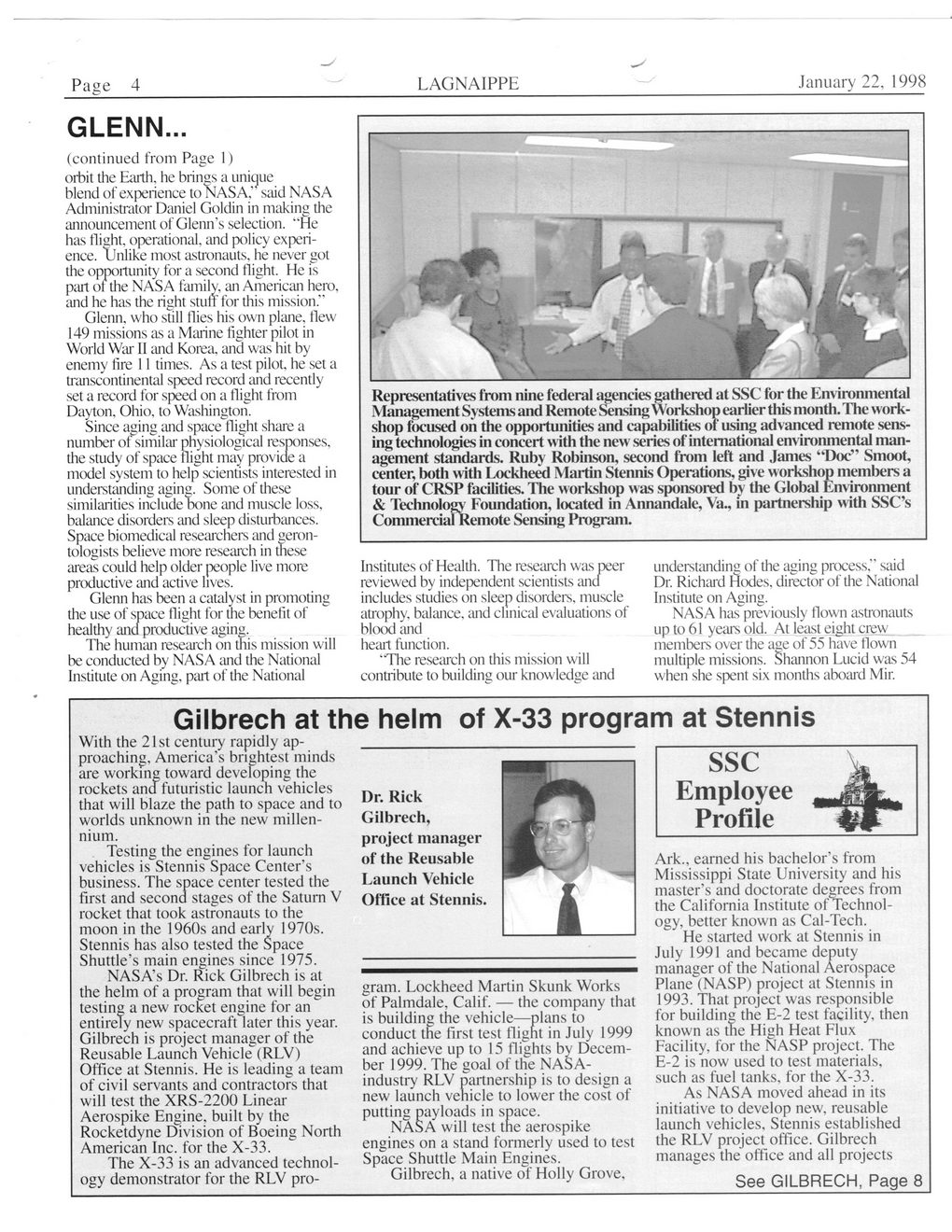This text was obtained via automated optical character recognition.
It has not been edited and may therefore contain several errors.
Page 4 LAGNAIPPE January 22, 1998 'V'- * Si Representatives from nine federal agencies gathered at SSC for the Environmental Management Systems and Remote Sensing Workshop earlier this month. The workshop focused on the opportunities and capabilities of using advanced remote sensing technologies in concert with the new series of international environmental management standards. Ruby Robinson, second from left and James “Doc” Smoot, center, both with I^ockheed Martin Stennis Operations, give workshop members a tour of CRSP facilities. The workshop was sponsored by the Global Environment & Technology Foundation, located in Annandale, Va., in partnership with SSC’s CommerdalKemote Sensing Program. GLENN... (continued from Page 1) orbit the Earth, he brings a unique blend of experience to NASA,' said NASA Administrator Daniel Goldin in making the announcement of Glenn's selection. “He has flight, operational, and policy experience. Unlike most astronauts, he never got the opportunity for a second flight. He is part of the NASA family, an American hero, and he has the right stuff for this mission.” Glenn, who still flies his own plane, flew 149 missions as a Marine fighter pilot in World War 11 and Korea, and was hit by enemy tire 11 times. As a test pilot, he set a transcontinental speed record and recently set a record for speed on a flight from Dayton. Ohio, to Washington. Since aging and space flight share a number of similar physiological responses, the study of space flight may provide a model system to help scientists interested in understanding aging. Some of these similarities include bone and muscle loss, balance disorders and sleep disturbances. Space biomedical researchers and gerontologists believe more research in these areas could help older people live more productive and active lives. Glenn has been a catalyst in promoting the use of space flight for the benefit of healthy ana productive agin<j. The human research on mis mission will be conducted by NASA and the National Institute on Aging, part of the National Institutes of Health. The research was peer reviewed by independent scientists and includes studies on sleep disorders, muscle atrophy, balance, and clinical evaluations of blood and heart function. “The research on this mission will contribute to building our knowledge and understanding of the aging process,” said Dr. Richard Hodes, director of the National Institute on Aging. NASA has previously flown astronauts up to 61 years old. At least eight crew members over the age of 55 have flown multiple missions. Shannon Lucid was 54 when she spent six months aboard Mir. Gilbrech at the helm of X-33 program at Stennis With the 21 st century rapidly ap- proaching, America’s brightest minds are working toward developing the rockets and futuristic launch vehicles that will blaze the path to space and to worlds unknown in the new millennium. Testing the engines for launch vehicles is Stennis Space Center’s business. The space center tested the first and second stages of the Saturn V rocket that took astronauts to the moon in the 1960s and early 1970s. Stennis has also tested the Space Shuttle’s main engines since 1975. NASA’s Dr. Rick Gilbrech is at the helm of a program that will begin testing a new rocket engine for an entirely new spacecraft later this year. Gilbrech is project manager of the Reusable Launch Vehicle (RLV) Office at Stennis. He is leading a team of civil servants and contractors that will test the XRS-2200 Linear Aerospike Engine, built by the Rocketdyne Division of Boeing North American Inc. for the X-33. The X-33 is an advanced technology demonstrator for the RLV pro- Dr. Rick Gilbrech, project manager of the Reusable Launch Vehicle Office at Stennis. gram. Lockheed Martin Skunk Works of Palmdale, Calif. — the company that is building the vehicle—plans to conduct the first test flight in July 1999 and achieve up to 15 flights by December 1999. The goal of the NASA-industry RLV partnership is to design a new launch vehicle to lower the cost of putting payloads in space. NASA will test the aerospike engines on a stand formerly used to test Space Shuttle Main Engines. Gilbrech, a native of Holly Grove, Ark., earned his bachelor’s from Mississippi State University and his master’s and doctorate degrees from the California Institute ofTechnol-ogy, better known as Cal-Tech. He started work at Stennis in July 1991 and became deputy manager of the National Aerospace Plane (NASP) project at Stennis in 1993. That project was responsible for building the E-2 test facility, then known as the High Heat Flux Facility, for the NASP project. The E-2 is now used to test materials, such as fuel tanks, for the X-33. As NASA moved ahead in its initiative to develop new, reusable launch vehicles, Stennis established the RLV project office. Gilbrech manages the office and all projects See GILBRECH, Page 8

NASA Document (018)